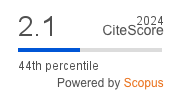Optimization of Deep Learning Technique for OFDM Receivers in 6G Wireless Communications
DOI:
https://doi.org/10.4108/eetiot.8536Keywords:
Deep Learning, Machine Learning, OFDM, 6G Communications, LS, MMSEAbstract
INTRODUCTION: This paper presents an innovative deep learning-based optimization technique for orthogonal frequency division multiplexing (OFDM) receivers in wireless communication systems.
OBJECTIVES: The proposed method utilizes an enhanced deep convolutional neural network (Enhanced DCNN) architecture with a time-frequency domain fusion mechanism to address the issues of interference and temporal information loss. The model incorporates attention mechanisms and causal convolutions to extract long-term dependencies within the received OFDM signals. It enables accurate channel estimation and signal recovery.
METHODS: The methodology is validated using simulations based on 3GPP-defined channel models. It includes extended typical U (ETU), extended pedestrian A (EPA) and extended vehicular A (EVA) across varying signal-to-noise ratio (SNR) conditions.
RESULTS: Results demonstrate that the proposed receiver significantly improves bit error rate (BER) performance compared to traditional Least Squares (LS) and LMMSE methods. Particularly, in scenarios with large delay spreads and high mobility. Additionally, the model has a lower computational complexity (CC) and thus is appropriate for real-time implementation.
CONCLUSION: We view this work as a strong scheme to improve the performance of OFDM systems in future wireless networks.
Downloads
References
[1] X. Chen, J. Tan, L. Kang, F. Tang, M. Zhao, and N. Kato, “Frequency selective surface towards 6g communication systems: A contemporary survey,” IEEE Communications Surveys & Tutorials, 2024. https://ieeexplore.ieee.org/document/10443962/
[2] P. S. Deepthi, V. S. Priyanka, R. Anil Kumar, and S. Kumar, “Review of 5g communications over ofdm and gfdm,” in ICCCE 2020: Proceedings of the 3rd International Conference on Communications and Cyber Physical Engineering, pp. 861–869, Springer, 2021. https://link.springer.com/chapter/10.1007/978-981-15-7961-5_81
[3] Nayak, Sabuzima, and Ripon Patgiri. "A Vision on Intelligent Medical Service for Emergency on 5G and 6G Communication Era." EAI Endorsed Transactions on Internet of Things 6, no. 22 (2020). https://publications.eai.eu/index.php/IoT/article/view/613
[4] Y. S. Hussein, M. Y. Alias, and A. A. Abdulkafi, “On performance analysis of ls and mmse for channel estimation in vlc systems,” in 2016 IEEE 12th International Colloquium on Signal Processing & Its Applications (CSPA), pp. 204–209, IEEE, 2016. http://ieeexplore.ieee.org/document/7515832
[5] K. Liu, F. Ke, X. Huang, R. Yu, F. Lin, Y. Wu, and D. W. K. Ng, “Deep ban: a temporal convolution-based communication framework for dynamic wbans,” IEEE Transactions on Communications, vol. 69, no. 10, pp. 6675– 6690, 2021. https://ieeexplore.ieee.org/document/9474477
[6] M. Meenalakshmi, S. Chaturvedi, and V. K. Dwivedi, “Deep learning techniques for ofdm systems,” IETE journal of research, vol. 69, no. 9, pp. 5883– 5897, 2023. https://www.tandfonline.com/doi/abs/10.1080/03772063.2021.1986154
[7] N. K. Kundu and M. R. McKay, “Channel estimation for reconfigurable intelligent surface aided miso communications: From lmmse to deep learning solutions,” IEEE Open Journal of the Communications Society, vol. 2, pp. 471–487, 2021. https://ieeexplore.ieee.org/document/9366894
[8] X. Yi and C. Zhong, “Deep learning for joint channel estimation and signal detection in ofdm systems,” IEEE Communications Letters, vol. 24, no. 12, pp. 2780–2784, 2020. https://ieeexplore.ieee.org/document/9159626
[9] A. Vaswani, P. Ramachandran, A. Srinivas, N. Parmar, B. Hechtman, and J. Shlens, “Scaling local self-attention for parameter efficient visual backbones,” in Proceedings of the IEEE/CVF Conference on Computer Vision and Pattern Recognition, pp. 12894–12904, 2021. https://ieeexplore.ieee.org/document/9578198
[10] M. K. Elmezughi1 and T. J. Afullo, “Performance analysis of ofdm scheme with channel estimation and doppler shift effects,” Albahit journal of applied sciences, vol. 2, no. 1, pp. 2–2, 2021. https://ieeexplore.ieee.org/document/6959021
[11] Y. Li, Y. Fan, S. Hou, Y. Niu, Y. Fu, and H. Li, “Reconstruction of ofdm signals using a dual discriminator cgan with bilstm and transformer,” Sen- sors, vol. 24, no. 14, p. 4562, 2024. https://www.mdpi.com/1424-8220/24/14/4562
[12] R. A. Kumar, R. P. Kumar, S. Patchala, and U. Sreenivasulu, “Performance of mimo-gfdm scheme for future wireless communications,” in 2024 International Conference on Knowledge Engineering and Communication Systems (ICKECS), vol. 1, pp. 1–6, IEEE, 2024. https://ieeexplore.ieee.org/document/10617288
[13] R. A. Kumar, A. Ramesh, S. Patchala, U. Sreenivasulu, and R. P. Kumar, “The performance analysis of precoded space-time frequency mimo-gfdm over rayleigh fading channels,” Journal of mechanics of continua and mathematical sciences 19 (9), pp 35-47, 2024. https://www.journalimcms.org/journal/the-performance-analysis-of-precoded-space-time-frequency-mimo-gfdm-over-rayleigh-fading-channels/
[14] Zhang, Caiya, Fang Fang, and Congsong Zhang. "A Self-Supervised GCN Model for Link Scheduling in Downlink NOMA Networks." EAI Endorsed Transactions on Internet of Things 10 (2024). https://publications.eai.eu/index.php/IoT/article/view/6039
Downloads
Published
Issue
Section
License
Copyright (c) 2025 Kasetty Lakshmi Narasimha, V. Saraswathi, Mummidi SubbaRaju, M. Koteswara Rao, Kapula Kalyani Kalyani, Anil Kumar R

This work is licensed under a Creative Commons Attribution-NonCommercial-ShareAlike 4.0 International License.
This is an open-access article distributed under the terms of the Creative Commons Attribution CC BY 4.0 license, which permits unlimited use, distribution, and reproduction in any medium so long as the original work is properly cited.




